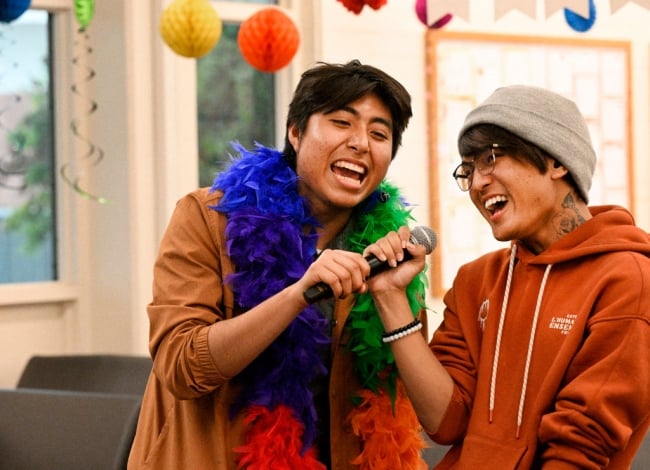You have /5 articles left.
Sign up for a free account or log in.

Isaac Campechano Roldan (left) and Elvis Prom sing karaoke at El Camino College in Torrance, Calif., on Wednesday, May 31, 2023. As a part of its Pride Week celebration, the college hosted a variety of activities running through June 3 to celebrate and embrace its LGBTQ+ students and employees.
June is Pride Month for the LGBTQ+ community, and many colleges and universities are finding ways to acknowledge and honor these community members.
Like their peers, LGBTQ+ students want to be involved and feel they belong at the institution. A September 2022 survey from the Trevor Project, a nonprofit focused on LGBTQ+ youth suicide prevention, found that suicidal ideation and suicide attempts were reduced when students had access to mental health and LGBTQ+ support services at college.
Inside Higher Ed compiled five examples of LGBTQ-focused actions being taken at institutions across the U.S. to promote belonging and inclusion for student success.
- Offer LGBTQ+ housing
Housing is one area that can feel particularly vulnerable for LGBTQ+ students if they don’t identify with the gender assigned to them at birth. LGBTQ-friendly housing, whether that’s a living-learning community or a gender-neutral floor, can make students feel more safe and included in their residential community.
Kent State University in Ohio offers a living-learning community focused on sexual orientation, gender identity and social justice for LGBTQ+ students. The LLC offers community classes in LGBTQ+ studies, lectures from the Study of Gender and Sexuality, and programming from the LGBTQ+ Center, among other resources.
- Host affirming events
A student’s feeling of belonging on campus is critical to retention and persistence. Campus events that include and recognize LGBTQ+ students can inspire feelings of belonging.
At Syracuse University, the LGBTQ Resource Center offered a Queer Clothing Swap as part of Trans Liberation Week to provide an easy, affordable source of gender-affirming clothing.
Among events focused on LGBTQ+ student inclusion, Marist College in New York hosts an ally network training, creating an identifiable network of individuals who can support LGBTQ+ issues and provide information and a safe space for community members.
During commencement season, many LGBTQ+ student organizations or centers host a Lavender Graduation ceremony, which recognizes LGBTQ+ students and allies and their achievements at the institution.
- Educate community members on LGBTQ+ issues
Institutions of higher education are designed to educate learners, and LGBTQ+ resources can engage the campus community in fostering an academic dialogue and understanding around LGBTQ+ issues.
Ohio University’s LGBT Center offers a workshop on respectful pronoun use and resources around pronouns and preferred names to educate community members on transgender, nonbinary and two-spirit identities.
Ferris State University’s LGBTQ+ Resource Center has a lending library dedicated to LGBTQ+-focused books and resources, which are free for students, faculty members and staff to check out.
At Ursinus College in Pennsylvania, community members can complete a Rainbow Passport challenge, which offers 11 ways for students, faculty and staff to facilitate inclusion in their personal lives. Examples include adding their pronouns to their email signature, attending an LGBTQ+ education event or following the gender and sexuality alliance on Instagram.
- Address LGBTQ+ needs in mental health supports
LGBTQ+ students have unique needs and challenges compared to their peers, so institutions should consider how to care for those needs.
At the College of the Holy Cross in Massachusetts, the counseling center has a dedicated coordinator for LGBTQ+ counseling services and programming to provide individual therapy and provide outreach and consultation to the greater campus community. In addition, all counseling staff receive special training in working with LGBTQ+ students. Holy Cross also offers a LGBTQ+ support group as well.
- Foster LGBTQ+ student/staff relationships
While gender and sexuality alliances (GSAs) often promote student connections among LGBTQ+ community members, campus communities can support LGBTQ+ students further by encouraging relationships with LGBTQ+ staff and faculty members.
Linfield University in Oregon offers queer mentoring for LGBTQ+ students looking for a supportive mentor. Linfield also has an LGBTQ employee group, allowing staff and faculty members to connect and socialize in a safe place.
El Camino College in California organized a community leaders panel for pride week, inviting campus members like faculty and staff to speak about how they can support the LGBTQ+ community.
If your student success program has a unique feature or twist, we’d like to know about it. Click here to submit.




